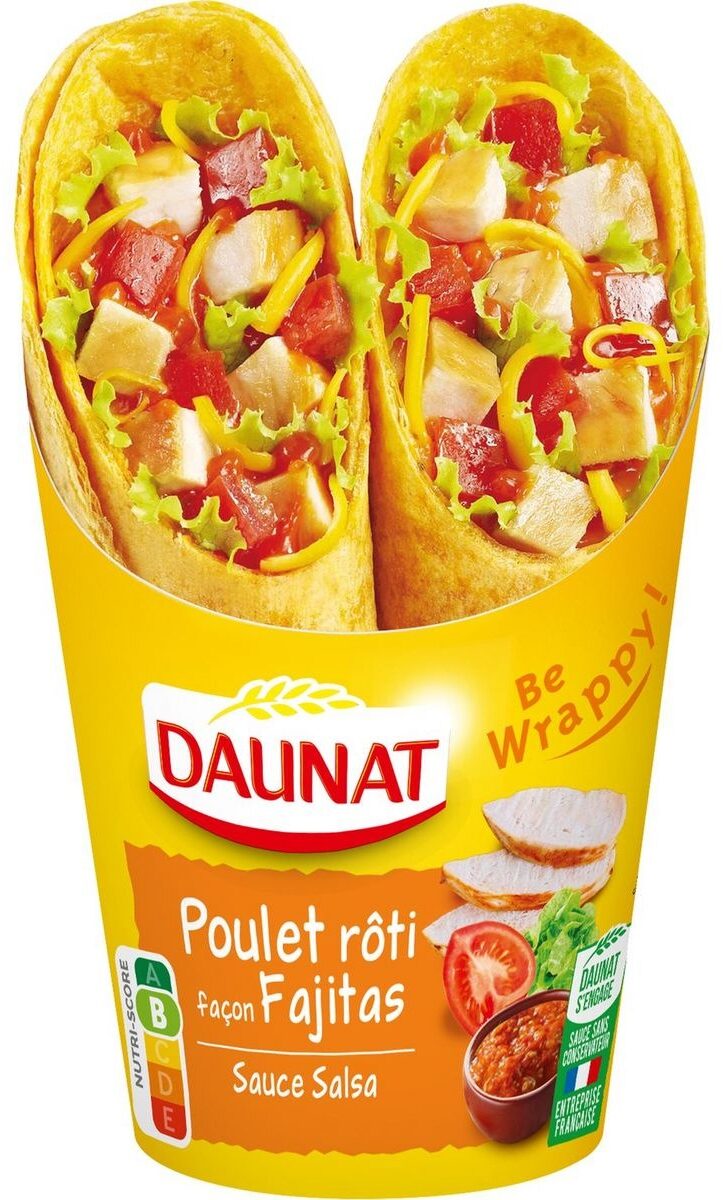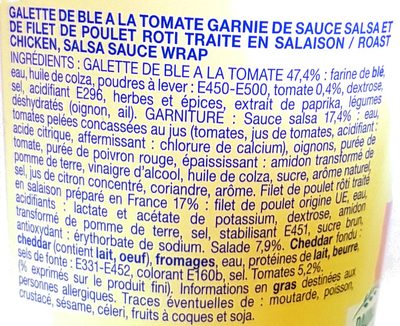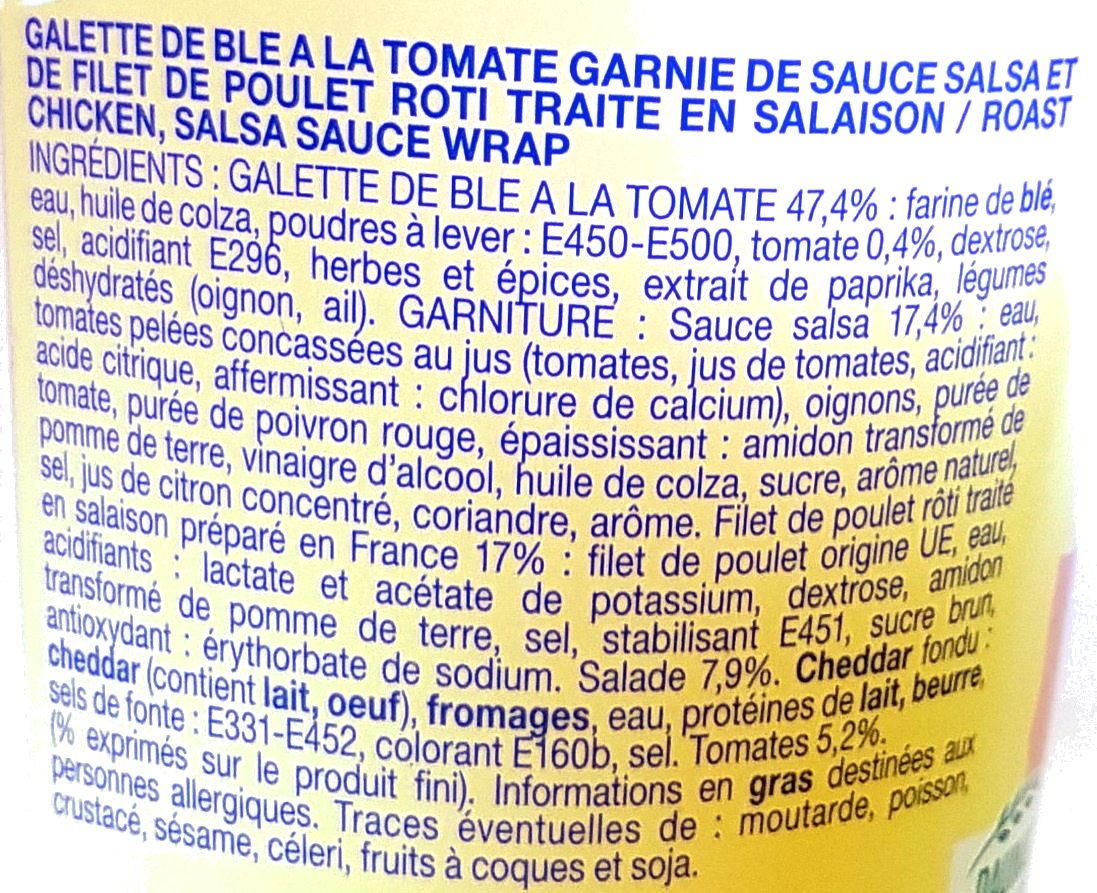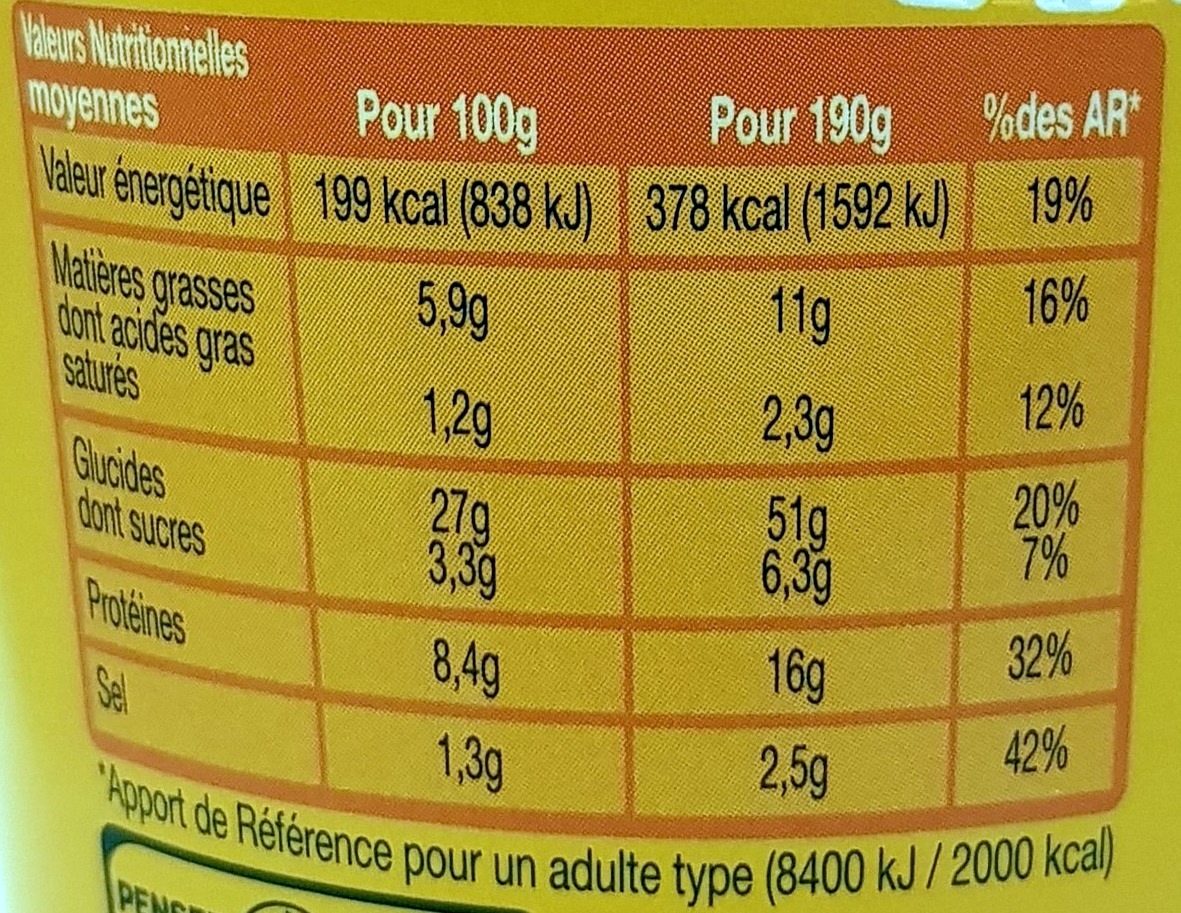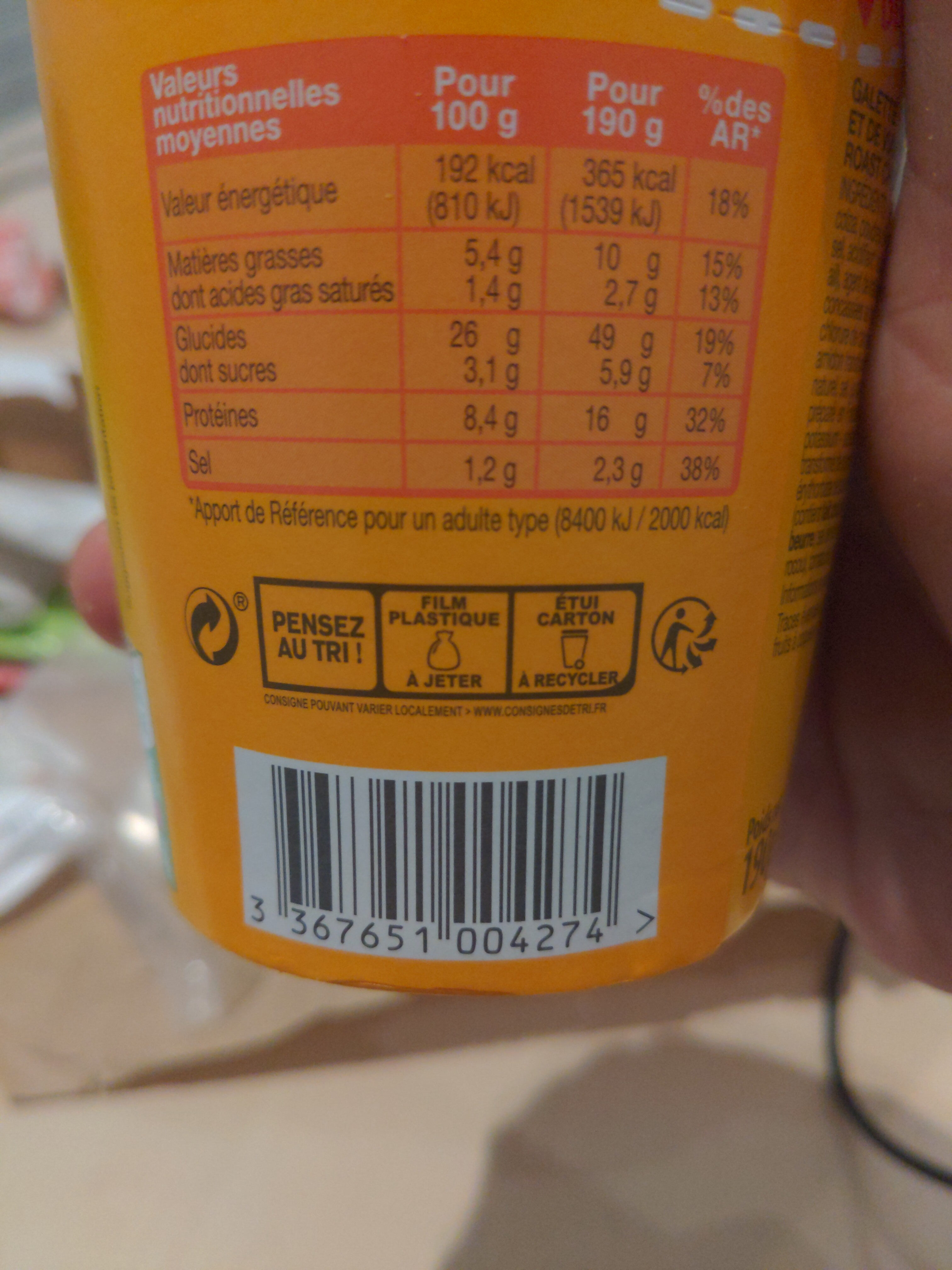Help us make food transparency the norm!
As a non-profit organization, we depend on your donations to continue informing consumers around the world about what they eat.
The food revolution starts with you!
Be wrappy poulet rôti façon fajitas - Daunat - 190 g
Be wrappy poulet rôti façon fajitas - Daunat - 190 g
This product page is not complete. You can help to complete it by editing it and adding more data from the photos we have, or by taking more photos using the app for Android or iPhone/iPad. Thank you!
×
Barcode: 3367651004274 (EAN / EAN-13)
Common name: Galette de blé à la tomate garnie de sauce salsa et de filet de poulet roti traité en salaison
Quantity: 190 g
Packaging: Plastic, Cardboard, Fresh, Protective gas, fr:Etui en carton, fr:Film en plastique
Brands: Daunat
Categories: Meals, Sandwiches, Poultry sandwiches, Wraps, Chicken sandwiches, Fajitas
Labels, certifications, awards:
No preservatives, Green Dot, Made in France, Nutriscore
Manufacturing or processing places: France
Link to the product page on the official site of the producer: http://www.daunat.com/produits/wraps/be-...
Stores: Super U, Magasins U, carrefour.fr
Countries where sold: France
Matching with your preferences
Health
Ingredients
-
67 ingredients
wheat cake with tomato 47.4%: wheat flour, water, rapeseed oil, baking powder: e450-e500, tomato 0.4%, dextrose, salt, acidifier e296, herbs and spices, paprika extract, dehydrated vegetables (onion, garlic), garnish: salsa sauce 17.4%: water, peeled tomatoes crushed in juice (tomatoes, tomato juice, acidifier: citric acid, firming: calcium chloride), onions, tomato puree, red pepper puree, thickener: processed potato starch, alcohol vinegar, rapeseed oil, sugar, natural flavour, salt, lemon juice concentrate, coriander, flavouring, roast chicken fillet treated in cured france 17%: chicken fillet eu origin, water, acidifiers: potassium lactate and acetate, dextrose, processed potato starch, salt, stabilizer e451, brown sugar, antioxidant: sodium erythorbate, salad 7.9%, melted cheddar: cheddar (contains milk, egg), cheese, water, milk protein, butter, melting salts: e331-e452, color e160b, salt, tomatoes 5.2%Allergens: Eggs, Gluten, MilkTraces: Celery, Crustaceans, Eggs, Fish, Mustard, Sesame seeds
Food processing
-
Ultra processed foods
Elements that indicate the product is in the 4 - Ultra processed food and drink products group:
- Additive: E14XX - Modified Starch
- Additive: E160b - Annatto
- Additive: E160c - Paprika extract
- Additive: E450 - Diphosphates
- Additive: E451 - Triphosphates
- Additive: E452 - Polyphosphates
- Ingredient: Colour
- Ingredient: Dextrose
- Ingredient: Firming agent
- Ingredient: Flavouring
- Ingredient: Glucose
- Ingredient: Milk proteins
- Ingredient: Thickener
Food products are classified into 4 groups according to their degree of processing:
- Unprocessed or minimally processed foods
- Processed culinary ingredients
- Processed foods
- Ultra processed foods
The determination of the group is based on the category of the product and on the ingredients it contains.
Additives
-
E261 - Potassium acetate
Potassium acetate: Potassium acetate -KCH3COO- is the potassium salt of acetic acid.Source: Wikipedia
-
E270 - Lactic acid
Lactic acid: Lactic acid is an organic compound with the formula CH3CH-OH-COOH. In its solid state, it is white and water-soluble. In its liquid state, it is colorless. It is produced both naturally and synthetically. With a hydroxyl group adjacent to the carboxyl group, lactic acid is classified as an alpha-hydroxy acid -AHA-. In the form of its conjugate base called lactate, it plays a role in several biochemical processes. In solution, it can ionize a proton from the carboxyl group, producing the lactate ion CH3CH-OH-CO−2. Compared to acetic acid, its pKa is 1 unit less, meaning lactic acid deprotonates ten times more easily than acetic acid does. This higher acidity is the consequence of the intramolecular hydrogen bonding between the α-hydroxyl and the carboxylate group. Lactic acid is chiral, consisting of two optical isomers. One is known as L--+--lactic acid or -S--lactic acid and the other, its mirror image, is D--−--lactic acid or -R--lactic acid. A mixture of the two in equal amounts is called DL-lactic acid, or racemic lactic acid. Lactic acid is hygroscopic. DL-lactic acid is miscible with water and with ethanol above its melting point which is around 17 or 18 °C. D-lactic acid and L-lactic acid have a higher melting point. In animals, L-lactate is constantly produced from pyruvate via the enzyme lactate dehydrogenase -LDH- in a process of fermentation during normal metabolism and exercise. It does not increase in concentration until the rate of lactate production exceeds the rate of lactate removal, which is governed by a number of factors, including monocarboxylate transporters, concentration and isoform of LDH, and oxidative capacity of tissues. The concentration of blood lactate is usually 1–2 mM at rest, but can rise to over 20 mM during intense exertion and as high as 25 mM afterward. In addition to other biological roles, L-lactic acid is the primary endogenous agonist of hydroxycarboxylic acid receptor 1 -HCA1-, which is a Gi/o-coupled G protein-coupled receptor -GPCR-.In industry, lactic acid fermentation is performed by lactic acid bacteria, which convert simple carbohydrates such as glucose, sucrose, or galactose to lactic acid. These bacteria can also grow in the mouth; the acid they produce is responsible for the tooth decay known as caries. In medicine, lactate is one of the main components of lactated Ringer's solution and Hartmann's solution. These intravenous fluids consist of sodium and potassium cations along with lactate and chloride anions in solution with distilled water, generally in concentrations isotonic with human blood. It is most commonly used for fluid resuscitation after blood loss due to trauma, surgery, or burns.Source: Wikipedia
-
E296 - Malic acid
Malic acid: Malic acid is an organic compound with the molecular formula C4H6O5. It is a dicarboxylic acid that is made by all living organisms, contributes to the pleasantly sour taste of fruits, and is used as a food additive. Malic acid has two stereoisomeric forms -L- and D-enantiomers-, though only the L-isomer exists naturally. The salts and esters of malic acid are known as malates. The malate anion is an intermediate in the citric acid cycle.Source: Wikipedia
-
E316 - Sodium erythorbate
Sodium erythorbate: Sodium erythorbate -C6H7NaO6- is a food additive used predominantly in meats, poultry, and soft drinks. Chemically, it is the sodium salt of erythorbic acid. When used in processed meat such as hot dogs and beef sticks, it increases the rate at which nitrite reduces to nitric oxide, thus facilitating a faster cure and retaining the pink coloring. As an antioxidant structurally related to vitamin C, it helps improve flavor stability and prevents the formation of carcinogenic nitrosamines. When used as a food additive, its E number is E316. The use of erythorbic acid and sodium erythorbate as a food preservative has increased greatly since the U.S. Food and Drug Administration banned the use of sulfites as preservatives in foods intended to be eaten fresh -such as ingredients for fresh salads- and as food processors have responded to the fact that some people are allergic to sulfites. It can also be found in bologna, and is occasionally used in beverages, baked goods, and potato salad.Sodium erythorbate is produced from sugars derived from different sources, such as beets, sugar cane, and corn. An urban myth claims that sodium erythorbate is made from ground earthworms; however, there is no truth to the myth. It is thought that the genesis of the legend comes from the similarity of the chemical name to the words earthworm and bait.Alternative applications include the development of additives that could be utilized as anti-oxidants in general. For instance, this substance has been implemented in the development of corrosion inhibitors for metals and it has been implemented in active packaging.Sodium erythorbate is soluble in water. The pH of the aqueous solution of the sodium salt is between 5 and 6. A 10% solution, made from commercial grade sodium erythorbate, may have a pH of 7.2 to 7.9. In its dry, crystalline state it is nonreactive. But, when in solution with water it readily reacts with atmospheric oxygen and other oxidizing agents, which makes it a valuable antioxidant.Source: Wikipedia
-
E330 - Citric acid
Citric acid is a natural organic acid found in citrus fruits such as lemons, oranges, and limes.
It is widely used in the food industry as a flavor enhancer, acidulant, and preservative due to its tart and refreshing taste.
Citric acid is safe for consumption when used in moderation and is considered a generally recognized as safe (GRAS) food additive by regulatory agencies worldwide.
-
E331 - Sodium citrates
Sodium citrate: Sodium citrate may refer to any of the sodium salts of citrate -though most commonly the third-: Monosodium citrate Disodium citrate Trisodium citrateThe three forms of the salt are collectively known by the E number E331. Sodium citrates are used as acidity regulators in food and drinks, and also as emulsifiers for oils. They enable cheeses to melt without becoming greasy.Source: Wikipedia
-
E450 - Diphosphates
Diphosphates (E450) are food additives often utilized to modify the texture of products, acting as leavening agents in baking and preventing the coagulation of canned food.
These salts can stabilize whipped cream and are also found in powdered products to maintain their flow properties. They are commonly present in baked goods, processed meats, and soft drinks.
Derived from phosphoric acid, they're part of our daily phosphate intake, which often surpasses recommended levels due to the prevalence of phosphates in processed foods and drinks.
Excessive phosphate consumption is linked to health issues, such as impaired kidney function and weakened bone health. Though diphosphates are generally regarded as safe when consumed within established acceptable daily intakes, it's imperative to monitor overall phosphate consumption to maintain optimal health.
-
E451 - Triphosphates
Sodium triphosphate: Sodium triphosphate -STP-, also sodium tripolyphosphate -STPP-, or tripolyphosphate -TPP-,- is an inorganic compound with formula Na5P3O10. It is the sodium salt of the polyphosphate penta-anion, which is the conjugate base of triphosphoric acid. It is produced on a large scale as a component of many domestic and industrial products, especially detergents. Environmental problems associated with eutrophication are attributed to its widespread use.Source: Wikipedia
-
E500 - Sodium carbonates
Sodium carbonates (E500) are compounds commonly used in food preparation as leavening agents, helping baked goods rise by releasing carbon dioxide when they interact with acids.
Often found in baking soda, they regulate the pH of food, preventing it from becoming too acidic or too alkaline. In the culinary world, sodium carbonates can also enhance the texture and structure of foods, such as noodles, by modifying the gluten network.
Generally recognized as safe, sodium carbonates are non-toxic when consumed in typical amounts found in food.
-
E509 - Calcium chloride
Calcium chloride: Calcium chloride is an inorganic compound, a salt with the chemical formula CaCl2. It is a colorless crystalline solid at room temperature, highly soluble in water. Calcium chloride is commonly encountered as a hydrated solid with generic formula CaCl2-H2O-x, where x = 0, 1, 2, 4, and 6. These compounds are mainly used for de-icing and dust control. Because the anhydrous salt is hygroscopic, it is used as a desiccant.Source: Wikipedia
Ingredients analysis
-
Palm oil free
No ingredients containing palm oil detected
Unrecognized ingredients: fr:galette-de-ble-a-la-tomate, fr:sauce-salsa, fr:filet-de-poulet-roti-traite-en-salaison-prepare-en-franceSome ingredients could not be recognized.
We need your help!
You can help us recognize more ingredients and better analyze the list of ingredients for this product and others:
- Edit this product page to correct spelling mistakes in the ingredients list, and/or to remove ingredients in other languages and sentences that are not related to the ingredients.
- Add new entries, synonyms or translations to our multilingual lists of ingredients, ingredient processing methods, and labels.
If you would like to help, join the #ingredients channel on our Slack discussion space and/or learn about ingredients analysis on our wiki. Thank you!
-
Non-vegan
Non-vegan ingredients: Melted cheddar, Cheddar, Cheese, Milk proteins, ButterSome ingredients could not be recognized.
We need your help!
You can help us recognize more ingredients and better analyze the list of ingredients for this product and others:
- Edit this product page to correct spelling mistakes in the ingredients list, and/or to remove ingredients in other languages and sentences that are not related to the ingredients.
- Add new entries, synonyms or translations to our multilingual lists of ingredients, ingredient processing methods, and labels.
If you would like to help, join the #ingredients channel on our Slack discussion space and/or learn about ingredients analysis on our wiki. Thank you!
-
Vegetarian status unknown
Unrecognized ingredients: fr:galette-de-ble-a-la-tomate, fr:sauce-salsa, fr:filet-de-poulet-roti-traite-en-salaison-prepare-en-franceSome ingredients could not be recognized.
We need your help!
You can help us recognize more ingredients and better analyze the list of ingredients for this product and others:
- Edit this product page to correct spelling mistakes in the ingredients list, and/or to remove ingredients in other languages and sentences that are not related to the ingredients.
- Add new entries, synonyms or translations to our multilingual lists of ingredients, ingredient processing methods, and labels.
If you would like to help, join the #ingredients channel on our Slack discussion space and/or learn about ingredients analysis on our wiki. Thank you!
-
Details of the analysis of the ingredients
We need your help!
Some ingredients could not be recognized.
We need your help!
You can help us recognize more ingredients and better analyze the list of ingredients for this product and others:
- Edit this product page to correct spelling mistakes in the ingredients list, and/or to remove ingredients in other languages and sentences that are not related to the ingredients.
- Add new entries, synonyms or translations to our multilingual lists of ingredients, ingredient processing methods, and labels.
If you would like to help, join the #ingredients channel on our Slack discussion space and/or learn about ingredients analysis on our wiki. Thank you!
: Galette de blé à la tomate 47.4% (farine de blé), eau, huile de colza, poudre à lever (e450), e500, tomate 0.4%, dextrose, sel, acidifiant (e296), herbes et épices, extrait de paprika, légumes déshydratés (oignon, ail), Garniture (sauce salsa 17.4%), eau, tomates pelées concassées au jus (tomates, jus de tomates, acidifiant (acide citrique), affermissant (chlorure de calcium)), oignons, purée de tomates, poivron rouge, épaississant (amidon transformé de pomme de terre), vinaigre d'alcool, huile de colza, sucre, arôme naturel, sel, jus de citron concentré, coriandre, arôme, Filet de poulet rôti traité en salaison préparé en France 17%, eau, acidifiants (lactate, acétate de potassium), dextrose, amidon transformé de pomme de terre, sel, stabilisant (e451), sucre brun, antioxydant (érythorbate de sodium), Salade 7.9%, Cheddar fondu (cheddar), fromages, eau, protéines de lait, beurre, sels de fonte (e331), e452, colorant (e160b), sel, Tomates 5.2%- Galette de blé à la tomate -> fr:galette-de-ble-a-la-tomate - percent: 47.4
- farine de blé -> en:wheat-flour - vegan: yes - vegetarian: yes - ciqual_proxy_food_code: 9410
- eau -> en:water - vegan: yes - vegetarian: yes - ciqual_food_code: 18066
- huile de colza -> en:colza-oil - vegan: yes - vegetarian: yes - from_palm_oil: no - ciqual_food_code: 17130
- poudre à lever -> en:raising-agent
- e450 -> en:e450 - vegan: yes - vegetarian: yes
- e500 -> en:e500 - vegan: yes - vegetarian: yes
- tomate -> en:tomato - vegan: yes - vegetarian: yes - ciqual_food_code: 20047 - percent: 0.4
- dextrose -> en:dextrose - vegan: yes - vegetarian: yes - ciqual_proxy_food_code: 31016
- sel -> en:salt - vegan: yes - vegetarian: yes - ciqual_food_code: 11058
- acidifiant -> en:acid
- e296 -> en:e296 - vegan: yes - vegetarian: yes
- herbes et épices -> en:herbs-and-spices - vegan: yes - vegetarian: yes
- extrait de paprika -> en:e160c - vegan: yes - vegetarian: yes
- légumes déshydratés -> fr:legume-deshydrate - vegan: yes - vegetarian: yes
- oignon -> en:onion - vegan: yes - vegetarian: yes - ciqual_food_code: 20034
- ail -> en:garlic - vegan: yes - vegetarian: yes - ciqual_food_code: 11000
- Garniture -> en:filling - vegan: maybe - vegetarian: maybe
- sauce salsa -> fr:sauce-salsa - percent: 17.4
- eau -> en:water - vegan: yes - vegetarian: yes - ciqual_food_code: 18066
- tomates pelées concassées au jus -> fr:tomates-pelees-concassees-au-jus - vegan: yes - vegetarian: yes - ciqual_food_code: 20047
- tomates -> en:tomato - vegan: yes - vegetarian: yes - ciqual_food_code: 20047
- jus de tomates -> en:tomato-juice - vegan: yes - vegetarian: yes - ciqual_food_code: 20047
- acidifiant -> en:acid
- acide citrique -> en:e330 - vegan: yes - vegetarian: yes
- affermissant -> en:firming-agent
- chlorure de calcium -> en:e509 - vegan: yes - vegetarian: yes
- oignons -> en:onion - vegan: yes - vegetarian: yes - ciqual_food_code: 20034
- purée de tomates -> en:tomato-puree - vegan: yes - vegetarian: yes - ciqual_food_code: 20170
- poivron rouge -> en:red-bell-pepper - vegan: yes - vegetarian: yes - ciqual_food_code: 20087
- épaississant -> en:thickener
- amidon transformé de pomme de terre -> en:modified-potato-starch - vegan: yes - vegetarian: yes - ciqual_proxy_food_code: 9510
- vinaigre d'alcool -> en:alcohol-vinegar - vegan: yes - vegetarian: yes - ciqual_food_code: 11018
- huile de colza -> en:colza-oil - vegan: yes - vegetarian: yes - from_palm_oil: no - ciqual_food_code: 17130
- sucre -> en:sugar - vegan: yes - vegetarian: yes - ciqual_proxy_food_code: 31016
- arôme naturel -> en:natural-flavouring - vegan: maybe - vegetarian: maybe
- sel -> en:salt - vegan: yes - vegetarian: yes - ciqual_food_code: 11058
- jus de citron concentré -> en:concentrated-lemon-juice - vegan: yes - vegetarian: yes - ciqual_food_code: 2028
- coriandre -> en:coriander - vegan: yes - vegetarian: yes
- arôme -> en:flavouring - vegan: maybe - vegetarian: maybe
- Filet de poulet rôti traité en salaison préparé en France -> fr:filet-de-poulet-roti-traite-en-salaison-prepare-en-france - percent: 17
- eau -> en:water - vegan: yes - vegetarian: yes - ciqual_food_code: 18066
- acidifiants -> en:acid
- lactate -> en:e270 - vegan: yes - vegetarian: yes
- acétate de potassium -> en:e261 - vegan: yes - vegetarian: yes
- dextrose -> en:dextrose - vegan: yes - vegetarian: yes - ciqual_proxy_food_code: 31016
- amidon transformé de pomme de terre -> en:modified-potato-starch - vegan: yes - vegetarian: yes - ciqual_proxy_food_code: 9510
- sel -> en:salt - vegan: yes - vegetarian: yes - ciqual_food_code: 11058
- stabilisant -> en:stabiliser
- e451 -> en:e451 - vegan: yes - vegetarian: yes
- sucre brun -> en:caramelised-sugar - vegan: yes - vegetarian: yes - ciqual_proxy_food_code: 31016
- antioxydant -> en:antioxidant
- érythorbate de sodium -> en:e316 - vegan: yes - vegetarian: yes
- Salade -> en:salad - vegan: yes - vegetarian: yes - percent: 7.9
- Cheddar fondu -> en:melted-cheddar - vegan: no - vegetarian: maybe - ciqual_food_code: 12726
- cheddar -> en:cheddar - vegan: no - vegetarian: maybe - ciqual_food_code: 12726
- fromages -> en:cheese - vegan: no - vegetarian: maybe - ciqual_proxy_food_code: 12999
- eau -> en:water - vegan: yes - vegetarian: yes - ciqual_food_code: 18066
- protéines de lait -> en:milk-proteins - vegan: no - vegetarian: yes
- beurre -> en:butter - vegan: no - vegetarian: yes - ciqual_proxy_food_code: 16400
- sels de fonte -> en:emulsifying-salts
- e331 -> en:e331 - vegan: yes - vegetarian: yes
- e452 -> en:e452 - vegan: yes - vegetarian: yes
- colorant -> en:colour
- e160b -> en:e160b - vegan: yes - vegetarian: yes
- sel -> en:salt - vegan: yes - vegetarian: yes - ciqual_food_code: 11058
- Tomates -> en:tomato - vegan: yes - vegetarian: yes - ciqual_food_code: 20047 - percent: 5.2
Nutrition
-
Average nutritional quality
⚠ ️Warning: the amount of fiber is not specified, their possible positive contribution to the grade could not be taken into account.⚠ ️Warning: the amount of fruits, vegetables and nuts is not specified on the label, it was estimated from the list of ingredients: 26This product is not considered a beverage for the calculation of the Nutri-Score.
Positive points: 5
- Proteins: 5 / 5 (value: 8.4, rounded value: 8.4)
- Fiber: 0 / 5 (value: 0, rounded value: 0)
- Fruits, vegetables, nuts, and colza/walnut/olive oils: 0 / 5 (value: 26.7057851552963, rounded value: 26.7)
Negative points: 8
- Energy: 2 / 10 (value: 833, rounded value: 833)
- Sugars: 0 / 10 (value: 3.3, rounded value: 3.3)
- Saturated fat: 1 / 10 (value: 1.2, rounded value: 1.2)
- Sodium: 5 / 10 (value: 520, rounded value: 520)
The points for proteins are counted because the negative points are less than 11.
Nutritional score: (8 - 5)
Nutri-Score:
-
Nutrient levels
-
Fat in moderate quantity (5.9%)
What you need to know- A high consumption of fat, especially saturated fats, can raise cholesterol, which increases the risk of heart diseases.
Recommendation: Limit the consumption of fat and saturated fat- Choose products with lower fat and saturated fat content.
-
Saturated fat in low quantity (1.2%)
What you need to know- A high consumption of fat, especially saturated fats, can raise cholesterol, which increases the risk of heart diseases.
Recommendation: Limit the consumption of fat and saturated fat- Choose products with lower fat and saturated fat content.
-
Sugars in low quantity (3.3%)
What you need to know- A high consumption of sugar can cause weight gain and tooth decay. It also augments the risk of type 2 diabetes and cardio-vascular diseases.
Recommendation: Limit the consumption of sugar and sugary drinks- Sugary drinks (such as sodas, fruit beverages, and fruit juices and nectars) should be limited as much as possible (no more than 1 glass a day).
- Choose products with lower sugar content and reduce the consumption of products with added sugars.
-
Salt in moderate quantity (1.3%)
What you need to know- A high consumption of salt (or sodium) can cause raised blood pressure, which can increase the risk of heart disease and stroke.
- Many people who have high blood pressure do not know it, as there are often no symptoms.
- Most people consume too much salt (on average 9 to 12 grams per day), around twice the recommended maximum level of intake.
Recommendation: Limit the consumption of salt and salted food- Reduce the quantity of salt used when cooking, and don't salt again at the table.
- Limit the consumption of salty snacks and choose products with lower salt content.
-
-
Nutrition facts
Nutrition facts As sold
for 100 g / 100 mlAs sold
per serving (190g)Compared to: Fajitas Energy 833 kj
(199 kcal)1,580 kj
(378 kcal)- Fat 5.9 g 11.2 g +27% Saturated fat 1.2 g 2.28 g +8% Carbohydrates 27 g 51.3 g -1% Sugars 3.3 g 6.27 g -20% Fiber ? ? Proteins 8.4 g 16 g +8% Salt 1.3 g 2.47 g -36% Fruits‚ vegetables‚ nuts and rapeseed‚ walnut and olive oils (estimate from ingredients list analysis) 26.706 % 26.706 %
Environment
-
Eco-Score B - Low environmental impact
⚠ ️Select a country in order to include the full impact of transportation.The Eco-Score is an experimental score that summarizes the environmental impacts of food products.→ The Eco-Score was initially developped for France and it is being extended to other European countries. The Eco-Score formula is subject to change as it is regularly improved to make it more precise and better suited to each country.Life cycle analysis
-
Average impact of products of the same category: B (Score: 68/100)
Category: Fajitas
Category: Fajitas
- PEF environmental score: 0.36 (the lower the score, the lower the impact)
- including impact on climate change: 2.47 kg CO2 eq/kg of product
Stage Impact Agriculture
63.5 %Processing
15.5 %Packaging
2.9 %Transportation
6.0 %Distribution
2.5 %Consumption
9.5 %
Bonuses and maluses
-
Origins of ingredients with a high impact
Malus: -5
Environmental policy: -5
Transportation: 0
Origin of the product and/or its ingredients % of ingredients Impact Unknown 100 %High European Union 0 %High
-
Packaging with a low impact
Malus: -2
Shape Material Recycling Impact Film Plastic High Sleeve Cardboard Low
Eco-Score for this product
-
Impact for this product: B (Score: 61/100)
Product: Be wrappy poulet rôti façon fajitas - Daunat - 190 g
Life cycle analysis score: 68
Sum of bonuses and maluses: -7
Final score: 61/100
-
Carbon footprint
-
Equal to driving 1.3 km in a petrol car
247 g CO² per 100g of product
The carbon emission figure comes from ADEME's Agribalyse database, for the category: Fajitas (Source: ADEME Agribalyse Database)
Stage Impact Agriculture
62.9 %Processing
16.8 %Packaging
4.2 %Transportation
10.8 %Distribution
1.5 %Consumption
3.8 %
Packaging
-
Packaging with a low impact
-
Packaging parts
Film (Plastic)
Sleeve (Cardboard)
-
Packaging materials
Material % Packaging weight Packaging weight per 100 g of product Paper or cardboard Plastic Total
-
Transportation
-
Origins of ingredients
Origins of ingredients with a high impact
Origin of the product and/or its ingredients % of ingredients Impact Unknown 100 %High European Union 0 %High
Report a problem
-
Incomplete or incorrect information?
Category, labels, ingredients, allergens, nutritional information, photos etc.
If the information does not match the information on the packaging, please complete or correct it. Open Food Facts is a collaborative database, and every contribution is useful for all.
Data sources
Product added on by ovattier
Last edit of product page on by kiliweb.
Product page also edited by amity, anrim, beniben, date-limite-app, driveoff, edwarner, hungergames, inf, magasins-u, openfoodfacts-contributors, packbot, quechoisir, roboto-app, sandrolecon, tacite, teolemon, thaialagata, yuka.U2FBdVNhQUF2S1JYaWN3bitCSHIwKzlFbTcyTEJFcWJPZm9PSWc9PQ, yuka.ZktJZUc2QlFwc2NQeGNjczNFdjB4ZnhhblpLR0FraXRBZnNUSWc9PQ.

